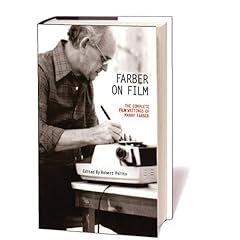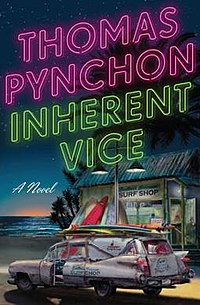Negative Space: Farber On Film and Inherent Vice
I wonder what Manny Farber thought about Thomas Pynchon. There's no question that the guy had an opinion because he had an opinion about everything, although he took great pains to make his position as abstract as possible. But Farber On Film doesn't include any of Farber's writing on art and I don't believe that he wrote about literature at all, so it is possible that I will never know what Farber actually thought about Pynchon unless Jonathan Rosenbaum or another such friend of Farber's drops by to chat.
Luckily, I have the power of conjecture and no obligations to any higher authority than the proprietor of this blog, who is, according to the note at the bottom of the page, me. So I'll surmise that Farber read about half of Gravity's Rainbow before he got bored (too artsy, too unfocused), but he quite liked The Crying Of Lot 49 because it shared a certain willingness to parade bitingly realistic comic grotesqueries with Farber's beloved Preston Sturges, a sense of satire that went everywhere and nowhere.
Everywhere and nowhere, as Jonathan Rosenbaum points out in this long essay on Farber's prickly genius, was an insult some writers directed at Farber's criticism. Farber's writing, like his beloved category of termite art, does tend to spill out of the frame. His points are often so mitigated that I cannot tell whether he liked a film or not. Maybe he himself couldn't tell. While reading this anthology, I often found myself wondering why Farber hated a certain film so much, only to find it cropping up on his year-end best-of list. His prose is filled with reversals, though, and all of his praise is filled with faint damnation and vice versa. What's most interesting about this book is that Farber's aesthetic philosophy seems mostly consistent and always insightful, even if his conclusions hardly ever feel conclusive. As he outlined in his epic essay on White Elephant Art and Termite Art (in short: white elephant art is self-consciously showy grand statement art, a la Titanic, anything with Robin Williams wearing a beard, or (in my opinion) Scorcese's bombastic later films, while termite art is economical and focused on the small moments, such as in the films of Farber's beloved Val Lewton, Werner Herzog, or Howard Hawks), Farber found more significance in narrative that doesn't try to direct the observer.
Many critics disliked Farber's thesis or were disturbed by his contrarian reviews. For instance, there's a delightful review of Farber's essay and a lively ensuing discussion at Girish here that dates back to 2006. Worth reading for the quotes of Farber's prose as it is for the fun in the comments. I think it's important to realize that Farber thought that both elements could coexist in the same film. They were categories of thought, an approach rather than an either/or dichotomy system, despite what Erik Nelson writes here in Salon. And I suspect that he hated far fewer movies than the sharp criticism of his essays would suggest. Movies that the man apparently couldn't stand in 1942 were praised again and again in later years. He didn't need his criticism to be conclusive, because taste is rarely fixed. Criticism that focuses exclusively on whether an artwork is good or bad fails both reader and writer (and I realize the irony of me saying this, but hey, I'm trying). And yet, criticism - itself an artwork - is almost always at its best when it is itself a termite art, eating its own boundaries in the pursuit of greater human experience.
Which brings things back to Pynchon. After I finished Farber On Film, I launched into Pynchon's latest, Inherent Vice and read it in three days flat. Inherent Vice is Pynchon's least ambitious novel, basically a Chandler novel (or, worse, Carl Hiaassen) as run through the Crying of Lot 49 and Vineland filter. Which makes it, more or less, a blood brother to The Big Lebowski. That lack of ambition awakened my newly Farberized awareness, as did Pynchon's B-movie fixated hero, Doc Sportello. Actually, it's not just Sportello who's constantly thinking about movies and comparing them to his (fictional) life, but many of the other characters, too. Which makes a point about how reality was becoming more unreal in the Southern California of the late 60s (the Charles Manson trial is contemporaneous with the action and constantly on the minds of all of the characters).
Unfortunately, it has nothing to add to the paranoia-as-rational-philosophy that has been an essential component of all of Pynchon's work. The characters, like the characters of Lot 49 and Vineland, are rightfully paranoid, rightfully assuming that their hedonism is under constant threat from forces of control and money, and rightfully too absorbed by their own drama and pursuit of happiness to do anything about it. This time period is a vital one to understanding Pynchon, and yet he'd never visited it in any of his books. But, coming as it does between the events of Lot 49 and the events of Vineland, one could surmise what Pynchon thought of the period without actually reading this shaggy-dog tale. Fortunately, the book is one of the funniest and breeziest in Pynchon's work, fun enough that readers don't really need to care that this story was not one that was crying out to be told. In his novels, Pynchon has rewritten history several times over, put magic and quantum theory to good use, fought bravely for personal freedoms, and developed a narrative style more influenced by the purely filmic storytelling of mise-en-scène and montage than any prior novelist. The guy could churn out Doc Sportello novels every six months for the rest of his life and I'd read every single one of them, laughing my ass off.
Luckily, I have the power of conjecture and no obligations to any higher authority than the proprietor of this blog, who is, according to the note at the bottom of the page, me. So I'll surmise that Farber read about half of Gravity's Rainbow before he got bored (too artsy, too unfocused), but he quite liked The Crying Of Lot 49 because it shared a certain willingness to parade bitingly realistic comic grotesqueries with Farber's beloved Preston Sturges, a sense of satire that went everywhere and nowhere.
Everywhere and nowhere, as Jonathan Rosenbaum points out in this long essay on Farber's prickly genius, was an insult some writers directed at Farber's criticism. Farber's writing, like his beloved category of termite art, does tend to spill out of the frame. His points are often so mitigated that I cannot tell whether he liked a film or not. Maybe he himself couldn't tell. While reading this anthology, I often found myself wondering why Farber hated a certain film so much, only to find it cropping up on his year-end best-of list. His prose is filled with reversals, though, and all of his praise is filled with faint damnation and vice versa. What's most interesting about this book is that Farber's aesthetic philosophy seems mostly consistent and always insightful, even if his conclusions hardly ever feel conclusive. As he outlined in his epic essay on White Elephant Art and Termite Art (in short: white elephant art is self-consciously showy grand statement art, a la Titanic, anything with Robin Williams wearing a beard, or (in my opinion) Scorcese's bombastic later films, while termite art is economical and focused on the small moments, such as in the films of Farber's beloved Val Lewton, Werner Herzog, or Howard Hawks), Farber found more significance in narrative that doesn't try to direct the observer.
Many critics disliked Farber's thesis or were disturbed by his contrarian reviews. For instance, there's a delightful review of Farber's essay and a lively ensuing discussion at Girish here that dates back to 2006. Worth reading for the quotes of Farber's prose as it is for the fun in the comments. I think it's important to realize that Farber thought that both elements could coexist in the same film. They were categories of thought, an approach rather than an either/or dichotomy system, despite what Erik Nelson writes here in Salon. And I suspect that he hated far fewer movies than the sharp criticism of his essays would suggest. Movies that the man apparently couldn't stand in 1942 were praised again and again in later years. He didn't need his criticism to be conclusive, because taste is rarely fixed. Criticism that focuses exclusively on whether an artwork is good or bad fails both reader and writer (and I realize the irony of me saying this, but hey, I'm trying). And yet, criticism - itself an artwork - is almost always at its best when it is itself a termite art, eating its own boundaries in the pursuit of greater human experience.
Which brings things back to Pynchon. After I finished Farber On Film, I launched into Pynchon's latest, Inherent Vice and read it in three days flat. Inherent Vice is Pynchon's least ambitious novel, basically a Chandler novel (or, worse, Carl Hiaassen) as run through the Crying of Lot 49 and Vineland filter. Which makes it, more or less, a blood brother to The Big Lebowski. That lack of ambition awakened my newly Farberized awareness, as did Pynchon's B-movie fixated hero, Doc Sportello. Actually, it's not just Sportello who's constantly thinking about movies and comparing them to his (fictional) life, but many of the other characters, too. Which makes a point about how reality was becoming more unreal in the Southern California of the late 60s (the Charles Manson trial is contemporaneous with the action and constantly on the minds of all of the characters).
Unfortunately, it has nothing to add to the paranoia-as-rational-philosophy that has been an essential component of all of Pynchon's work. The characters, like the characters of Lot 49 and Vineland, are rightfully paranoid, rightfully assuming that their hedonism is under constant threat from forces of control and money, and rightfully too absorbed by their own drama and pursuit of happiness to do anything about it. This time period is a vital one to understanding Pynchon, and yet he'd never visited it in any of his books. But, coming as it does between the events of Lot 49 and the events of Vineland, one could surmise what Pynchon thought of the period without actually reading this shaggy-dog tale. Fortunately, the book is one of the funniest and breeziest in Pynchon's work, fun enough that readers don't really need to care that this story was not one that was crying out to be told. In his novels, Pynchon has rewritten history several times over, put magic and quantum theory to good use, fought bravely for personal freedoms, and developed a narrative style more influenced by the purely filmic storytelling of mise-en-scène and montage than any prior novelist. The guy could churn out Doc Sportello novels every six months for the rest of his life and I'd read every single one of them, laughing my ass off.












0 comments:
Post a Comment